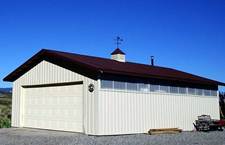Skylights in Barn You Built for us Need Replacing
Reader MICHELLE in ASTORIA writes:
“Hello! You built our barn located in Astoria, Oregon. The sky lights that were installed now need to be replaced. My husband called and was told you’d get back to us with no response. We are hoping to either hire you or to buy the sky lights through you. We look forward to hearing from you.”
Mike the Pole Barn Guru responds:
You are now finding out why Hansen Pole Buildings does not provide post frame buildings with skylights – they will fail.
A request we receive frequently is for skylights to be installed in our post frame buildings’ steel covered roofs.
My first thoughts go back to a building I worked inside of over a winter 40 years ago. About 20 years old, this building had a steel roof with numerous fiberglass (actually Fiberglass Reinforced Plastic or FRP) panels. These panels were designed and placed with an intent of allowing natural light into this very large building. Operative word here being “were”.
FRP panels are strong mold-resistant sheets. Over time glazed pigmented seal applied during manufacturing processes can crack causing structural breakdown of fiberglass resin by weathering. On this particular building, these skylights had deteriorated to a less than lovely yellow color, allowing very little light transmission. Lateral loads being transferred through roofing from wind had elongated screw holes, causing numerous roof leaks.
Brittleness over time is another issue with FRP. At my first truss manufacturing plant, we constructed a new building in 1982, with FRP panels at the south facing sidewall top. Our idea was to be able to gain natural lighting. Within a matter of just a few years, these panels had yellowed and become brittle. Local kids, out for “fun” were even throwing rocks through them!
Available technologies have improved. For use in post frame buildings, most instances where FRP panels would have been used, is now being done by polycarbonates.
 Polycarbonate panels are designed specifically to match up to metal panel profiles. With a high performance glazing, standing up to punishing exterior applications, Polycarbonate panels offer multiple advantages over traditional FRP panels: up to 20 times greater impact resistance, highest light transmission rates, lowest yellowing index, highest load rating, and highest resistance to wind uplift-outstanding properties confirmed in accredited laboratory testing and in installations worldwide since 1984. Polycarbonate panels are virtually unbreakable, they self-extinguish if exposed to flame, are hail resistant and are Underwriters Laboratory (UL) 580 Class 90 recognized.
Polycarbonate panels are designed specifically to match up to metal panel profiles. With a high performance glazing, standing up to punishing exterior applications, Polycarbonate panels offer multiple advantages over traditional FRP panels: up to 20 times greater impact resistance, highest light transmission rates, lowest yellowing index, highest load rating, and highest resistance to wind uplift-outstanding properties confirmed in accredited laboratory testing and in installations worldwide since 1984. Polycarbonate panels are virtually unbreakable, they self-extinguish if exposed to flame, are hail resistant and are Underwriters Laboratory (UL) 580 Class 90 recognized.
Polycarbonate roof panels are normally used as in-plane translucent panels and are used with steel panels. Instead, we recommend these skylights be used in walls as eave lights to allow light into buildings and to prevent anyone from walking on and falling through these panels.
If you are really planning on using polycarbonate roof panels, then you cannot insulate your roof in these areas, or you will block all sunlight. Roof areas without a good vapor barrier are prone to condensation issues as well. You’ll also have to take some precautions about thermal movement. Polycarbonate panels do expand and contract much more than steel panels and they are much weaker and deflect more.
We’ve had an engineer perform full scale testing of steel panels similar to what is used on your new Hansen Pole Building (our tests were performed using thinner 30 gauge steel). These tests resulted in shear values for these panels being published in National Frame Builders Association’s (NFBA) Post-Frame Building Design Manual. With a minimum allowable shear strength of 110 pounds per lineal foot, this steel is virtually identical in strength to 7/16” oriented strand board (osb) installed in an unblocked diaphragm (no blocking at seams between sheets of osb).
Properly installed steel roofing, has shear strength to be able to transfer loads induced by wind or seismic forces across roofs, through building endwalls, to ground. Herein lies an issue with light panels (either FRP or Polycarbonate). They have no shear strength. In adding light panels, a roof’s structural integrity could be compromised. Under lateral loads, panels could fracture or buckle, or the building frame itself could be overstressed.
We at Hansen Buildings searched our database and could not find Michelle, or her email address, in it. Turns out (to no surprise) we did not construct her building (or anyone’s building as we are not contractors) and she is off in search of her actual builder!







